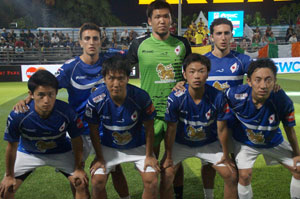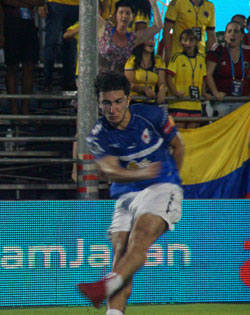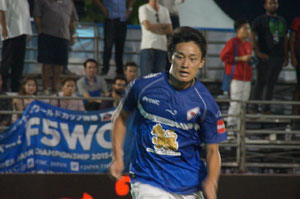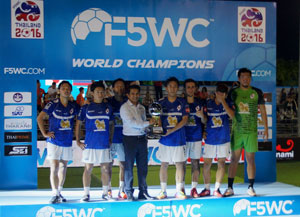Top>HAKUMON Chuo [2016 Early Spring Issue]>Chuo University represented Japan with an outstanding performance Finishing in Second Place at F5WC
 Index
Index

Photograph of Japanese team members taken immediately prior to the championship game. From left, the front row is Hayashi, Lee, Toba, and Muramoto. The back row is Azawui Ahamado, Ishikawa, and Azawui Reis.
Chuo University represented Japan with an outstanding performance
Finishing in Second Place at F5WC
The championship game of the Football Five’s World Championship 2016 (F5WC) was held in Bangkok, Thailand on March 5, to determine the world’s No. 1 team from 32 countries and regions. The Japanese team consisted of seven athletes, five of which were Chuo University students. Although Japan lost to Columbia in the championship by a score of 1-3, they finished second in the world and made their presence felt in the sport of football fives.
(Cooperation: F5WC JAPAN Secretariat)
Their opponent in the championship game was Columbia, a South America powerhouse which was undefeated en route to the game. The Columbian team uses an aggressive press defense.
“It was the best experience I have ever had in playing soccer”

The vigorous play of Azawui Reis
Just before halftime, Japan suffered a defensive lapse and surrendered a goal. In the second minute of the second half, Japan was given a numbers advantage due to a foul by a Columbian player. However, perhaps due to impatience, they gave up a second goal in the fourth minute.
After another goal put them behind 0-3, Japan finally scored its first goal in the ninth minute of the second half. Azawui Reis (4th-year student in the Faculty of Economics) scored with a shot from his left foot. Following Azawui’s goal, the Japanese team created a number of chances, but was ultimately stopped by the Columbian defense.
After the end of the championship game, the Japanese team received a welcome announcement. As the only team to have finished the entire tournament without getting a red card, the team had been awarded the Fair Play Prize.
“It was the best experience that I have ever had in playing soccer,” says Captain Takehiro Muramoto (32). “I haven’t had many opportunities to compete in international tournaments, and I never imagined that we would make it to the championship game. I’m disappointed that we weren’t able to win, but every game that we competed in increased my love for the game of soccer.” Muramoto’s comments reflected the feelings of the entire team.
Fair Play Prize

Lee concentrates on the play
The seven athletes captured the opportunity to represent Japan by winning the “At-Home Football Fives,” a preliminary tournament featuring 240 teams from throughout Japan. Their team is composed mostly of Chuo students and their team name is “Tama-Chan.” The team is widely known through the Tama region.
Jongsu Lee (4th-year student in the Faculty of Economics) entered Chuo University from Maebashi Ikuei High School, a renowned powerhouse in high school soccer. While in high school, Lee was co-captain of the soccer team. He had planned to stop playing soccer when he graduated from university.
Lee was offered the chance to try football fives by Muramoto, who would later become captain of the Japanese team at F5WC. Muramoto has a long history of playing futsal and currently plays in the Second Division League of Tokyo Futsal.
Lee was interested in the idea of playing soccer with five people. From April, he would be busy every day after graduating and starting to work. Also, it was difficult to gather together enough people in order to play a conventional game of soccer with 11 people to a team. However, football fives would give him an opportunity to play again. It would also help him to manage and improve his health, something necessary to survive in the business world.
For someone who loves soccer as much as Lee, football fives was extraordinarily appealing.
After emerging victorious from a preliminary tournament held among 32 teams in Japan, Tama-Chan earned the right to compete in the F5WC world championships.
“I had played in national tournaments, but never in an international tournament,” says Lee. “When I started playing football fives, I thought that it would be the final chapter of my soccer career. I never dreamed that it would lead me to competing against the world.”
The sport of football fives is easy to confuse with futsal, which has the same number of people and uses the same size field. However, venues for football fives are much bigger. Also, the two sports use different balls. Football fives uses a soccer ball (low-bound type).
“Since a soccer ball is used, soccer techniques can be used without any need for change,” explained Azawui Reis. “That’s a nice aspect of the sport.” Azawui Reis also plays in Second Division futsal league.
“Since the field is small, the transition from attacking to defending is very important, which makes this sports enjoyable even in a short period of time.” says Takuma Ishikawa (4th-year student in the Faculty of Law) when explaining other appealing aspects of football fives. Ishikawa is a well-muscled man and a true goalkeeper. He was selected as MVP of the All Japan High School Soccer Tournament when he was a member of the team at Asahikawa-Jitsugyo High School.
Feeling pride at representing Japan in amateur sports

The Japanese team receives a trophy on the awards platform
During his time with the Kashima Antlers Youth Soccer Team, Masato Toba (4th-year student in the Faculty of Economics) wore No. 10, which is assigned to ace players. Toba says that football fives is appealing because it doesn’t require the same tactics as futsal. He hopes that more people will try the sport.
“Anybody can start football fives at any times,” says Hiroyuki Hayashi (4th-year student in the Faculty of Commerce) when discussing the social aspects of the sport. “It’s a great way to meet new people.” Hayashi scored three goals in F5WC, second on the team behind the five goals by leading scorer Azawui Ahamado.
“We support the people who pursue for their dreams even if they currently play soccer or used to do so seriously,” says Yutaro Shimizu (graduate of Chuo University), a member of the F5WC Japan Secretariat and employee of Sunny Side Up, Inc.
The vision of the F5WC Japan Secretariat is “to enable Japanese athletes to compete internationally and feel pride in representing Japan in amateur soccer, even if they are not members of the Japanese national team.”
Football fives will continue to give birth to new dreams.
▼Championship Game
| Columbia | 3 | 1-0 | 1 | Japan [Scored by] Azawui Reis (Chuo University) |
|---|---|---|---|---|
| 2-1 |
▼Finals Tournament
| 1st Game | 2-1 South Africa [Azawui Ahamado; Jongsu Lee (Chuo University)] |
|---|---|
| Quarter-Finals | 3-0 England [Azawui Reis, Masato Toba (Chuo University); Azawui Ahamed] |
| Semi-Finals | 0-0 Ireland |
| PK | (4-3) × Lee, ○ Azawui Ahamed, ○ Toba, ○ Lee, ○ Azawui Reis |
▼Preliminary League: Group E (Japan, America, India, Turkey)
| 2 wins, 1 draw (entered final tournament as 2nd seed from group) | Japan 1 - 1 America, Japan 3 - 2 Turkey, Japan 5 - 0 India |
|---|
Japanese Team (Five Chuo University students marked with an “X”)
| No. | Name | Affiliation | |
|---|---|---|---|
| X | 1 | Takuma Ishikawa | 4th-year student in the Faculty of Law |
| 2 | Takehiro Muramoto | Captain | |
| 3 | Azawui Ahamado | Toin University of Yokohama | |
| X | 4 | Azawui Reis | 4th-year student in the Faculty of Economics |
| X | 5 | Jongsu Lee | 4th-year student in the Faculty of Economics |
| X | 6 | Hiroyuki Hayashi | 4th-year student in the Faculty of Commerce |
| X | 7 | Masato Toba | 4th-year student in the Faculty of Economics |
<More Information>
Game time: Two 10-minute halves
Men age 16 and older are eligible to compete. Professional athletes cannot compete. A maximum of seven people can be registered to a team.
Game time is composed of two 10-minute halves. Players consist of four backs and one goalkeeper. An unlimited number of substitutions can be made freely at any point in the game without the need to obtain permission from the referee. The offside rule does not apply.
World championships began from 2013
The first football fives F5WC was held in Dubai in 2013, with 32 countries participating in the tournament. Japan first competed in F5WC during the second tournament which was held in April 2015 and featured teams from 44 countries. The Japanese team was named Shibata Komuten and was grouped in a preliminary league with Denmark, Saudi Arabia, and Luxembourg. The Japanese team finished with a record of one win and two losses.
Number of teams increasing rapidly in each country
The number of teams in each participating country at the time of the first F5WC was about 1,500 in England, 800 in America, 500 in Belgium, 300 in both Denmark and Singapore, and 270 in China. At the time of the second F5WC, the number of teams had increased to about 7,000 in America and 2,000 in England. This shows that the popularity of soccer is spreading.
Games watched by Scholes, etc.
Scouts from top European and American soccer teams watch the F5WC with great interest. Players have received offers from Manchester City Football Club, Chelsea Football Club, and Major League Soccer (MLS).
Games at the recent tournament were watched by Paul Scholes, a former member of the British national team, and Míchel Salgado, a former member of the Spanish national team. These renowned players created excitement by participating in exhibition matches.
A bar? A long-nosed goblin?
The names of Japanese teams are very unique. During the preliminary tournament held in Japan, Chuo students competed against strong teams with names such as “Luida’s Bar” (semi-final) and “Karasutengu” (final round).
- Research Activities as a Member of Research Fellowship for Young Scientists (DC1), Japan Society for the Promotion of Science (JSPS) Shuma Tsurumi
- Important Factors for Innovation in Payment Services Nobuhiko Sugiura
- Beyond the Concepts of Fellow Citizens and Foreigners— To Achieve SDGs Goal 10 “Reduce Inequality Within and Among Countries” Rika Lee
- Diary of Struggles in Cambodia Fumie Fukuoka
- How Can We Measure Learning Ability?
—Analysis of a Competency Self-Assessment Questionnaire— Yu Saito / Yoko Neha - The Making of the Movie Kirakira Megane








